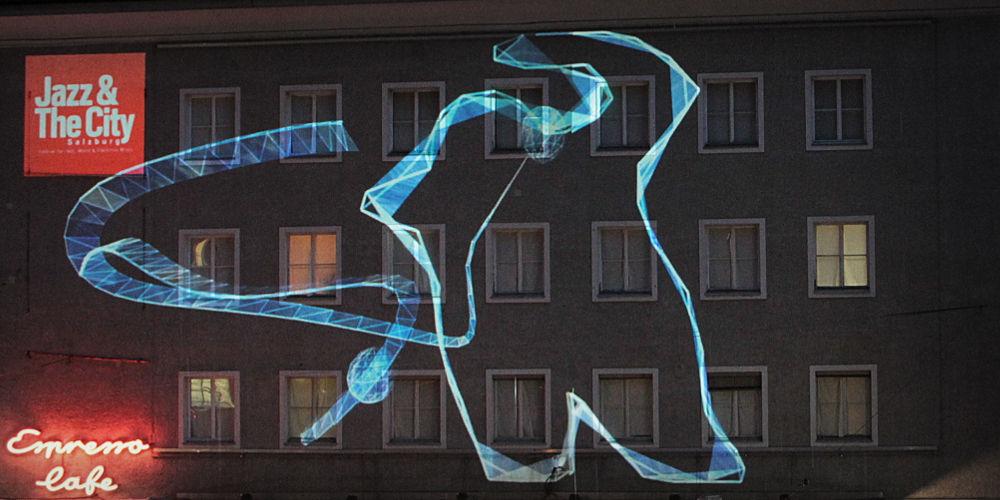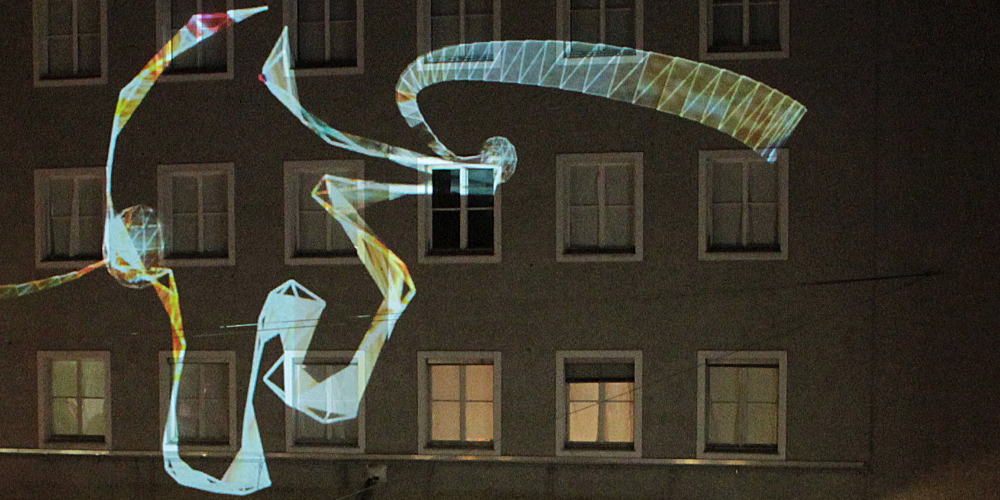 Osc Fluctuation (Credit: Thomas Wagner)
Osc Fluctuation (Credit: Thomas Wagner)
We’re pleased to announce that two great public showcases have been lined up for the 2014 Ars Electronica Festival. In conjunction with a research project named CADET (Center for Advances in Digital Entertainment Technologies), the Ars Electronica Futurelab has been working together with the Salzburg University of Applied Sciences in order to combine their technical and design skills and thereby to decisively strengthen the creative engineering sector in Austria. CADET’s objectives are the conception and development of technologies and applications in the area of mixed reality entertainment.
At the 2014 Ars Electronica Festival, the project staff will present two interactive dance installations produced with technologies developed by the CADET project. They’re entitled “Moves Reloaded” and “OscFluctuation.” Robert Praxmarer of the Salzburg University of Applied Sciences played a decisive role in both of them. In this interview, he reveals what festivalgoers can expect from these two installations.
 Salzburg has been collaborating with the Ars Electronica Futurelab in the CADET research initiative for several years now. What potential do you see in this form of cooperation?
Salzburg has been collaborating with the Ars Electronica Futurelab in the CADET research initiative for several years now. What potential do you see in this form of cooperation?
Robert Praxmarer: The potential is enormous because these efforts are situated at the interface of R&D, teaching and commercial practice, which makes it possible to test innovative, experimental approaches to determine if they could eventually be successfully marketed.
What areas is this initiative focusing its research on?
Robert Praxmarer: We’re concentrating our R&D efforts on enhancing immersion, participation and interaction in digital entertainment and communication. In other words, our approach is to question our understanding of multimedia production and entertainment, and to significantly change how things are done. One of these focal points is tracking technology for indoor and outdoor public events. This could have to do with anything from precisely positioning drones to locating pedestrians in a public space, whatever—we’re attempting to develop algorithms and software for these problems, and to test them with experimental prototypes. Another area of emphasis is human-machine interfaces of the future—in other words, the question of how I can interact with a computer using my body or only my thoughts.
[vimeo 73441892 w=610&h=320]
What does “Moves Reloaded” have in store for Ars Electronica Festivalgoers?
Robert Praxmarer: “Moves Reloaded” is a sort of endless interactive music video, a dance installation in which visitors can become part of an endless choreography. Participating visitors perform their best dance moves three second long, during which our system records everything and then creates a long music video that stylistically matches the music.
How can guests at the Ars Electronica Festival take part in “Moves Reloaded”?
Robert Praxmarer: It’s very simple: all you have to do is move in some way—dance, hop, whatever—for three seconds … anything goes. Meanwhile, you’re being filmed by a 3-D camera.
 MovesReloaded (Credit: Robert Praxmarer)
MovesReloaded (Credit: Robert Praxmarer)
What technologies were used for “Moves Reloaded”?
Robert Praxmarer: All we needed was a Kinect Version 2 from Microsoft and a modern computer.
The second installation is entitled “OscFluctuation.” What’s that all about?
Robert Praxmarer: It’s a sort of interactive, audiovisual instrument that enables installation visitors to control sounds and computer graphics with their dance movements. This jazz improvisation tool projects the movements of the recorded silhouettes of passers-by in jumbo format onto the side of a building, and the recorded movements are reflected in the windows. In addition, the movements are translated into sound parameters. So the result is continual improvisation of music, movement and algorithms.
[vimeo 77980572 w=610&h=320]
What does the name OscFluctuation mean?
Robert Praxmarer: It’s an artificial word derived from oscillation and fluctuation, both concepts from music, harmonics, thermodynamics and quantum mechanics. We wanted to express the idea of bringing together movement, frequency, improvisation and harmony.
What can visitors to this interactive installation do?
Robert Praxmarer: In this installation, visitors can make music and dance. And they can see enormously enlarged images of themselves projected onto the side of a building.
How many people can participative simultaneously?
Robert Praxmarer: At present, the installation works best with a single person, but maybe we’ll eventually find the time to integrate a multiple player mode.
 What are the biggest challenges in producing this?
What are the biggest challenges in producing this?
Robert Praxmarer: Definitely the setup, since the installation is outdoors and we have to bridge long cable distances via wireless network. Here, latencies and delays can crop up that, in turn, disrupt the interactivity.
Does it also work in the rain?
Robert Praxmarer: Yeah, but an umbrella would definitely be a good idea …
Would you like to take part in this interactive dance installation? Then come to the Ars Electronica Festival September 4-8, 2014. Details are available online at https://ars.electronica.art/c/.
